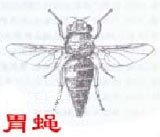The horse stomach fly belongs to the family Gastridae of the order Diptera, and its larvae live in the stomach of the host. The body is medium to large. 9 to 18 mm long. The whole body is densely covered with long yellow-brown or yellow-white hairs, which is a strong fly. The eyes are large and single. The antennae are thin, in the facial groove, and the antennal awns are hairless. The beak is short and the mouthparts are degenerated. The chest has soft hair, the scutes are large, and the back scutes are missing. The wings are large, and the branches of the subanterior veins and radial veins are close to the anterior edge veins. The midrib extends backward to the trailing edge, sometimes bending downward, but never upward. The hip vein 1A reaches the wing edge; the transverse veins on the top of the wing disappear, and the axillary veins disappear. Petals small. The abdomen is long, pointed, and oval. The male fly has an abdominal tip; the female fly's ovipositing tube is large and prominent. The eggs are slightly triangular or stalked, glued to the hair, with the tip downward, and two or more are gathered together in one place.

The larvae are 12 to 18 mm long. Cylindrical shape, the front end is slightly pointed, and the end is much larger than the front end; there are two pairs of mouth hooks. Each segment of the body has one or two rows of short thorns. The larvae often parasitize in the digestive tracts of horses, donkeys, mules and other domestic animals, but they also parasitize in the stomachs of dogs, rabbits and humans, so they are called "stomach flies". Sometimes the larvae invade the human skin and form tortuous tunnels under the skin, and raised stripes can be seen on the surface.
The horse stomach fly lives in the stomachs of horses, donkeys, and mules. The adults look like bees. Body length 16-20 mm. It flies slowly and lays eggs on the hair on the horse's front legs, shoulders, chest and abdomen. The eggs are slender and light yellow, and hatch in 10-14 days.
The larvae live on the hair. When the horse's tongue licks the fur, the fine hairy larvae are passed from the tongue lips to the mouth, where they invade the tissue and reach the stomach. It is often attached to the stomach wall with a hard hook hook to obtain nutrients. It passes through the summer, autumn and winter in the stomach, and is excreted from the body in the next spring. The pupae form in the soil and take 3-5 weeks to emerge. Northwest my country and Inner Mongolia are the most common; distributed throughout the world.
animal tags: Diptera Gastridae pest
We created this article in conjunction with AI technology, then made sure it was fact-checked and edited by a Animals Top editor.